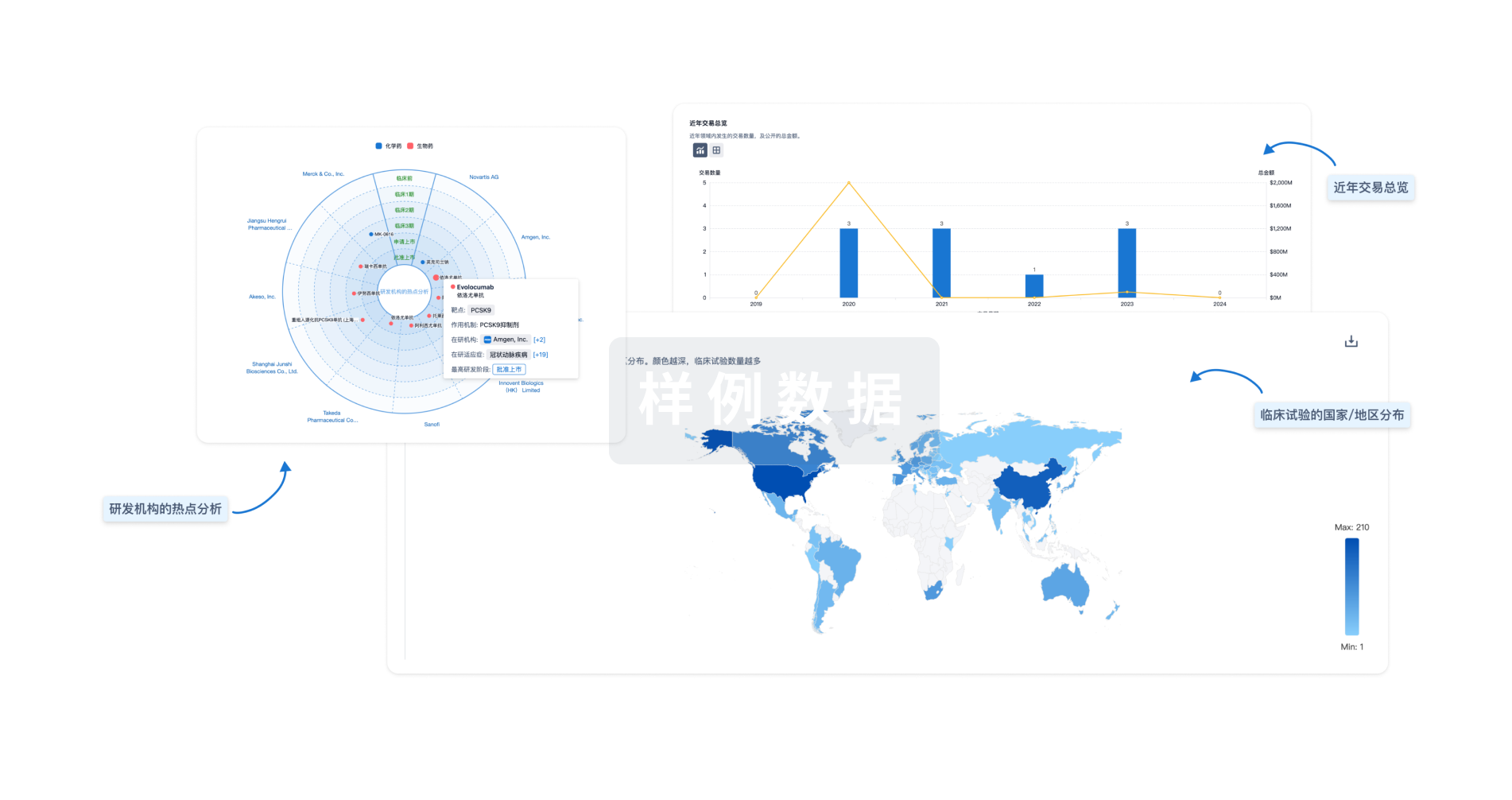预约演示
更新于:2025-05-07
S100A10
更新于:2025-05-07
基本信息
别名 42C、ANX2LG、CAL1L + [10] |
简介 Because S100A10 induces the dimerization of ANXA2/p36, it may function as a regulator of protein phosphorylation in that the ANXA2 monomer is the preferred target (in vitro) of tyrosine-specific kinase. |
关联
100 项与 S100A10 相关的临床结果
登录后查看更多信息
100 项与 S100A10 相关的转化医学
登录后查看更多信息
0 项与 S100A10 相关的专利(医药)
登录后查看更多信息
497
项与 S100A10 相关的文献(医药)2025-12-01·Inflammation Research
Single-cell hdWGCNA reveals a novel diagnostic model and signature genes of macrophages associated with chronic obstructive pulmonary disease
Article
作者: Zhou, Xianqiang ; Feng, Cuiling ; Zhang, Yixin ; Jin, Zhengjie ; Wang, Hongtao ; Meng, Yufeng ; Yang, Jie
2025-08-01·Computational Biology and Chemistry
Comprehensive analysis of single-cell and bulk transcriptome unravels immune landscape of atherosclerosis and develops a S100 family based-diagnostic model
Article
作者: Zhang, Wen-Song ; Lu, Shan ; Wang, Dan ; Hu, Yifang ; Wang, Jizheng ; Ge, Yaoqi ; Mo, Yanfei ; Liu, Yun ; Zhang, Rihua ; Hu, Yanyan ; Qin, Xiaoxuan
2025-06-01·Brain Research Bulletin
DL-3-n-butylphthalide inhibits astrocyte activation in the cortical penumbra of ischemia-reperfusion model rats via AKT signaling
Article
作者: Ji, Yifei ; Li, Biao ; Yu, Yiwen ; Xiao, Yu ; Li, Qiuling ; Wang, Shan ; Dong, Fei ; Wang, Tinghong ; Zhao, Hao ; Lei, Dong
1
项与 S100A10 相关的新闻(医药)2024-08-09
·微信
【导读】肝细胞癌(HCC)是一种常见的恶性肿瘤,具有复杂的免疫逃逸机制,给治疗带来了挑战。S100A10基因在多种肿瘤中的作用已引起广泛关注。
8月8日,复旦大学研究团队在期刊《Cell Death&Disease》上发表了研究论文,题为“Elucidating the role of S100A10 in CD8+ T cell exhaustion and HCC immune escape via the cPLA2 and 5-LOX axis”,本研究旨在阐明S100A10通过cPLA2和5-LOX轴对CD8+ T细胞耗竭的影响,从而阐明其在肝癌免疫逃逸中的作用。通过分析GEO和TCGA数据库中HCC相关数据,研究人员识别了与脂质代谢相关的差异表达基因,并建立了预后风险模型。随后,通过RNA-seq和PPI分析,研究人员确定了与CD8+ T细胞浸润显著相关的重要脂质代谢基因和下游因子S100A10, ACOT7和SMS。鉴于表达差异最显著,研究人员选择S100A10进行进一步研究。研究人员发现S100A10在肝癌组织中显著高表达,并可能通过cPLA2和5-LOX轴调节CD8+ T细胞耗竭和脂质代谢重编程。沉默S100A10可抑制CD8+ T细胞耗竭,进一步抑制肝癌的免疫逃逸。S100A10可能通过激活cPLA2和5-LOX轴,启动脂质代谢重编程,上调LTB4水平,从而促进肝癌组织中CD8+ T细胞耗竭,促进肝癌细胞的免疫逃逸,最终影响肝癌细胞的生长和迁移。本研究揭示了S100A10通过cPLA2和5-LOX轴在HCC免疫逃逸中的关键作用,为HCC的诊断和治疗提供了新的理论基础和潜在靶点。
https://www.nature.com/articles/s41419-024-06895-0#Sec34
背景知识
01
肝细胞癌(HCC)是世界范围内最常见的恶性肿瘤之一,是肝癌的主要形式。这类癌症主要与慢性乙型和丙型肝炎病毒感染、酒精性肝病和非酒精性脂肪性肝病有关。肝癌的诊断和治疗一直是医学界的难题。由于在最初阶段没有明确的症状,相当多的患者在诊断时已经进展到晚期,从而限制了替代治疗和预后。此外,HCC的变异性、肝脏解剖的复杂性和肿瘤的侵袭性进一步加剧了治疗的挑战。免疫逃逸在肝癌的发生发展中起着关键作用。肿瘤通过不同的机制抑制免疫系统的反应,例如,通过表达抑制T细胞活性的免疫抑制因子。然而,这一局限性不仅阻碍了传统免疫治疗的有效性,也为新型治疗方法的开发打开了大门,如特异性靶向PD-1/PD-L1通路的抑制剂。尽管在治疗和诊断方面存在挑战,但对潜在机制的全面理解,尤其是免疫逃逸,已经产生了新的治疗方法,并使人们乐观。
生物信息学与RNA转录组测序(RNA-seq)的整合是生物医学研究的有力工具,能够全面识别基因表达模式,从而研究疾病机制和治疗靶点。在肝细胞癌(HCC)中,RNA-seq有效地识别了遗传异常和新的转录改变。这为深入了解HCC的发生、发展和转移提供了重要线索。通过生物信息学方法,本研究预测S100A10可能参与HCC。此外,该基因可能与肝癌的免疫逃逸有关,提示其参与抑制免疫反应和促进肿瘤生长。
然而,S100A10在HCC免疫逃避中的作用尚不清楚。根据之前的文献,S100A10和cPLA2蛋白之间存在相互作用。cPLA2在细胞信号传递中起着至关重要的作用。如果激活不当,它会导致多种癌症的发生。因此,整合生物信息学和RNA-seq技术阐明了HCC的基本分子机制,并确定了S100A10作为一个有前景的治疗靶点。对S100A10和cPLA2相互作用的进一步研究将为HCC的治疗提供新的途径和方法。
S100A10可能与肝癌诱导的CD8+ T细胞耗竭有关
02
为了识别参与HCC中脂质代谢重编程的关键基因,研究人员从体外培养的MIHA肝细胞和MHCC97-L细胞中分别获取了3个正常样本和3个HCC样本,并进行了RNA-seq高通量测序和差异分析,共获得131个与脂代谢相关的差异表达基因。研究人员将RNA-seq得到的131个脂质代谢差异表达基因与用于构建Lasso模型的15个脂质代谢差异基因取交集,得到8个关键基因:S100A10、PRDX6、APEX1、SMS、ACSL3、ACOT7、PRKAA2和ME1。
随后,研究人员进一步分析上述8个关键脂代谢基因与患者生存时间及CD8+ T细胞浸润的相关性。结果显示,这8个基因与患者的生存时间显著相关(均p < 0.01),而仅S100A10、ACOT7和SMS与CD8+ T细胞浸润显著相关。研究人员进一步检测S100A10、ACOT7和SMS在两种正常肝细胞(MIHA、LX-2)和三种肝癌细胞(HCCLM3、Huh-7、MHCC97-L)中的mRNA和蛋白表达水平。结果显示,与正常肝细胞相比,肝癌细胞中S100A10、ACOT7和SMS的mRNA和蛋白表达均显著上调,其中S100A10的差异最为显著。据报道,S100A10在包括HCC在内的多种癌组织中高表达,并促进癌细胞的增殖和迁移。
S100A10与肝癌患者生存时间及CD8+ T细胞的相关性
因此,研究人员认为S100A10可能是肝癌诱导CD8+ T细胞耗竭的关键因素。
通过体内实验,研究人员发现沉默S100A10抑制了NOD-SCID小鼠肿瘤的生长和迁移,并恢复了肿瘤组织中CD8+ T细胞的功能,表明S100A10沉默有效抑制了肿瘤组织中CD8+ T细胞的耗竭,从而抑制了肝癌细胞的免疫逃逸。既往研究表明,T细胞耗竭在免疫功能紊乱和肿瘤免疫逃逸中发挥重要作用。在所有肿瘤浸润淋巴细胞中,CD8+ T细胞是通过执行T细胞受体介导的杀伤恶性细胞来进行抗肿瘤免疫的主要亚群。CD8+ T细胞浸润与肿瘤患者总生存率的提高之间的相关性已被充分证实。S100A10有望成为肝细胞癌新的治疗靶点。
研究小结
03
综上,研究人员初步提出以下假设:S100A10可能激活cPLA2和5-LOX-LOX轴,其中信号激活导致脂质代谢重编程,上调LTB4水平,从而促进HCC组织中CD8+T细胞耗竭,导致HCC细胞免疫逃逸,最终影响HCC细胞的生长和迁移。本研究为治疗HCC提供了新的视角和一定理论依据。
参考资料:https://www.nature.com/articles/s41419-024-06895-0#Sec34
识别微信二维码,添加生物制品圈小编,符合条件者即可加入
生物制品微信群!
请注明:姓名+研究方向!
版
权
声
明
本公众号所有转载文章系出于传递更多信息之目的,且明确注明来源和作者,不希望被转载的媒体或个人可与我们联系(cbplib@163.com),我们将立即进行删除处理。所有文章仅代表作者观点,不代表本站立场。
免疫疗法
分析
对领域进行一次全面的分析。
登录
或

生物医药百科问答
全新生物医药AI Agent 覆盖科研全链路,让突破性发现快人一步
立即开始免费试用!
智慧芽新药情报库是智慧芽专为生命科学人士构建的基于AI的创新药情报平台,助您全方位提升您的研发与决策效率。
立即开始数据试用!
智慧芽新药库数据也通过智慧芽数据服务平台,以API或者数据包形式对外开放,助您更加充分利用智慧芽新药情报信息。
生物序列数据库
生物药研发创新
免费使用
化学结构数据库
小分子化药研发创新
免费使用